
Exhibition Benefactor:
Frank Klein
Thank you to all our generous donors who support our exhibitions program.
ISBN: 978-1-7349033-6-2
Cover artwork by Betty Hahn
Catalog design by YellowDog, Denver, Colorado
Contents copyright ©2022 Studio Art Quilt Associates, Inc. Images copyright the individual artists. Images may not be reproduced or used in any way without written permission. All rights reserved.
PO Box 141
Hebron CT 06248
860.530.1551
www.saqa.com
About
Studio Art Quilt Associates, Inc. (SAQA) is an international nonprofit organization whose mission is to promote the art quilt, “a creative visual work that is layered and stitched or that references this form of stitched layered structure.”
Founded in 1989, SAQA now has over 4,000 members worldwide: artists, teachers, collectors, gallery owners, museum curators, and art quilt enthusiasts.
SAQA is dedicated to bringing beautiful, thoughtprovoking, cutting-edge artwork to venues across the globe. With access to a museum-quality exhibition program, SAQA members challenge the
boundaries of art and change perceptions about contemporary fiber art. These exhibitions not only give artists the opportunity to show their work, but also expose the public to the variety and complexity of the art quilt medium.
In addition, SAQA documents the art quilt movement through exhibition catalogs. These serve not only as preservation and educational tools, but also as sources of inspiration and beauty to be returned to again and again.
To learn more about SAQA and art quilts, visit www.saqa.com.
v
Juror’s Essay
In combing through the many splendid pieces submitted to Fur, Fangs, Feathers & Fins, I kept bumping into one particular question: what does “wildness” mean from within our newly minted Anthropocene Epoch? Is it something to which we belong, or something from which we are excluded? And is it even something which truly still exists at all?
While all of the pieces here focus upon the experience of the animal, the human is never far. We are both the creators of refuges and destroyers of ecosystems, and through it all we behold the world around us, but we are also beheld back.
At the time I wrote this, the COVID-19 pandemic was releasing its hold in some corners of the world, only to tighten its grip in others. Our collective attention has largely been on humanity and all our suffering, innovation, resilience, and folly; for many, true wilderness has been unreachable over the past sixteen months. Locked within the confines of our dwellings, some of us have plunged into the depths of photo albums and hard drives to seek inspiration from journeys past, while others have looked deeper into their own yards for the hints and traces of wildness there. But what is true for every tableau, whether it depicts an Eastern American birch grove or the East African savannah, is that one person’s exotic is another person’s back yard.
Everything, in the end, is about perspective. In global cultures, the animal has long been a foil for that which is difficult to capture about the human experience. In image and word, we project our own emotions and motivations onto the beasts of the field, the sky, and the sea. Yet in truth, they retain their own subjectivity, inscrutable other consciousnesses with whom we share an increasingly beleaguered planet.
Describing artist Mark Dion’s work, Steve Baker once wrote, “If the neatly edged fox is dissolved into her environment so that all we see is an ecosystem, our current ethical concepts do not really get a purchase.” Perhaps this is a way of beginning to reframe how we perceive the living world around us, such that we may we grasp our mutual interdependence before it is too late for us all.
— Emily Jan
Emily Jan is a Montreal-based artist and writer. Her biophilic sculptures and installations combine everyday found objects with meticulously worked raw materials to evoke the faraway and the fantastical. As a wanderer, naturalist, and collector of objects and stories, she is guided in her work by the spirit of kinship and exploration. Recent exhibitions include Wild at the Textile Museum of Canada, Toronto (2019), Castaways at the Bateman Foundation Gallery of Nature, Victoria (2020), and Grow Op: After the Flood at the Gladstone Hotel, Toronto (2018).
1
The Artists
3
Mary Lou Alexander
Hubbard, Ohio | USA
This image is distilled from a photo that I took of a herd of wild zebras on a trip to South Africa. It remains an indelible memory.
Cotton, fiber reactive dye, ink, photograph Computer manipulated, screen printed, machine pieced and quilted

4

5 Geometry of the Herd 56 x 69 inches | 2016
Diana Bartelings
Rock Creek, British Columbia | Canada
The spirit of the sockeye salmon is strong. These fish show power and determination, fighting against impossible odds to get to where they need to be. Facing all the obstacles that mankind has put in their path, they still seek to return to their spawning pools to perpetuate the next generation. They are in a transformative state when they spawn, changing from silver-green to brilliant red. Once their lives are expended, their bodies decay, going back into the waters where they were born.

6
Cotton
Screen printed, Shibori dyed, machine pieced and quilted

7 Spirit Salmon 51 x 24 inches | 2021
Sharon V. Buck
Newport, Tennessee | USA
The forest rings with the cries of the pileated woodpecker. Their distinctive drumming carries a long way as they hammer likely trees searching for grubs. As this mated pair flies through their kingdom, a trio of skeptical, irreverent chickadees look on, ready to chatter their gossipy opinions about their royal “betters.”

8
Acrylic paint, fabric Painted, tiled, appliquéd, free motion stitched

9
of the Forest
| 2021
Lords
40.5 x 53 inches
Photo by Tiffany Danielle
Betty Busby
Albuquerque, New Mexico | USA
The mystery of the deep is evoked with this collection of extraordinary creatures. Created on artist-dyed silk with stenciled oil stick, the pieces are accentuated with handcouched cording and glass eyes. The background is hand stitched with hundreds of clear glass beads.
Silk, rayon cord, glass beads, cotton Stenciled, machine stitched, hand stitched, hand corded, beaded

10

The Abyss 42 x 36 inches | 2017 11
Holly Lei Cole Triangle, Virginia | USA
These Asian elephants are part of my Vanishing Species series. Elephants are famous for their close family bonding and the difficulty of their lifestyle in the wild. I wanted to allow the viewer to see the world from the baby elephant’s perspective, and to that end the piece is true to the full scale of Asian elephants. The extensive free motion quilting creates an elephant skin texture throughout.
Canvas, cotton, dye, fabric paint
Drawn, dyed, painted, free motion quilted

12

The Toto 74 x 58 inches | 2012 13
Shannon M. Conley
Moore, Oklahoma | USA
Growing up in New Mexico, I’d never seen a real armadillo until we passed one dead on the side of the road while driving back from my sister’s graduation. I expressed great sadness for the poor dead baby armadillo. My sister, whose college years in Texas had provided many opportunities to see this familiar form of roadkill, laughed and said that it wasn’t a baby, it was an adult armadillo. With great indignation, I informed her that full-grown armadillos were about the size of cows. Despite the incredulity of everyone in the car, I continued to insist. Clearly, the children’s alphabet book that had informed my knowledge of armadillos was not a reliable scientific source. This quilt is a cheeky homage to something my family will never let me live down.
Recycled plastic jugs, vintage crochet doilies, light and electron microscopy photos, rubber stoppers, lace trims, paint, fabric, foam, felt Sculpted, hand and machine stitched, painted

14
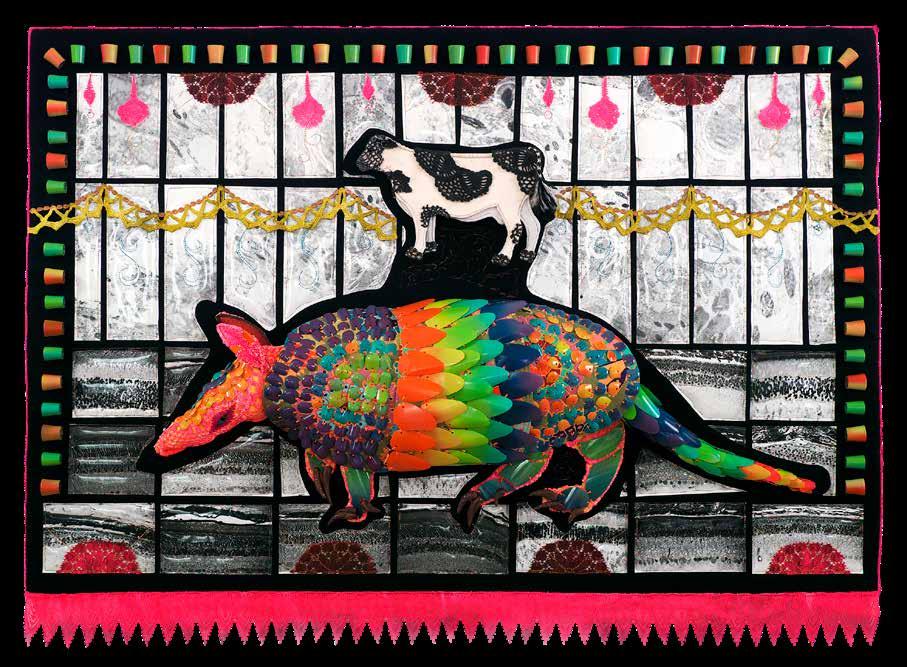 The Armadillo and the Cow
35 x 49 x 4 inches | 2021
The Armadillo and the Cow
35 x 49 x 4 inches | 2021
15
Photo by Mike Cox
Maria Eugenia Corbella
Pozuelo de Alarcón, Madrid | Spain
Neofelis nebulosa is part of a series of quilts about endangered species, with the aim to raise awareness and protect them. The clouded leopard lives in India, China, Myanmar, Indochina, Sumatra, and Borneo.

Taiwan’s subspecies became extinct in 1990 because of human selfishness. I’m a biologist and a quilter. In my quilts I fuse my two passions, helping those who view my art become aware of the damage we are doing to our environment.
Artist-dyed fabric
Appliquéd, free motion quilted, dyed
16

Neofelis nebulosa 49 x 29 inches | 2019 17
Rhonda S. Denney
Emporia, Kansas | USA
It’s no wonder that the bald eagle is the symbol of the United States. I wanted to capture the majesty of this bird of prey. Animals are constantly alert to the environment around them. Most use their sight to survive, but not all animals see the world in the same way and eyes are unique to each species.
Philosopher Martin Buber said, “An animal’s eyes have the power to speak a great language.” This quilt is part of a series in which I want to capture the allure and power of different animals and their eyes, be they mammal, bird, reptile, or insect. To me animal eyes are a large part of their distinctiveness and character, and I love the challenge of recreating that in my art.
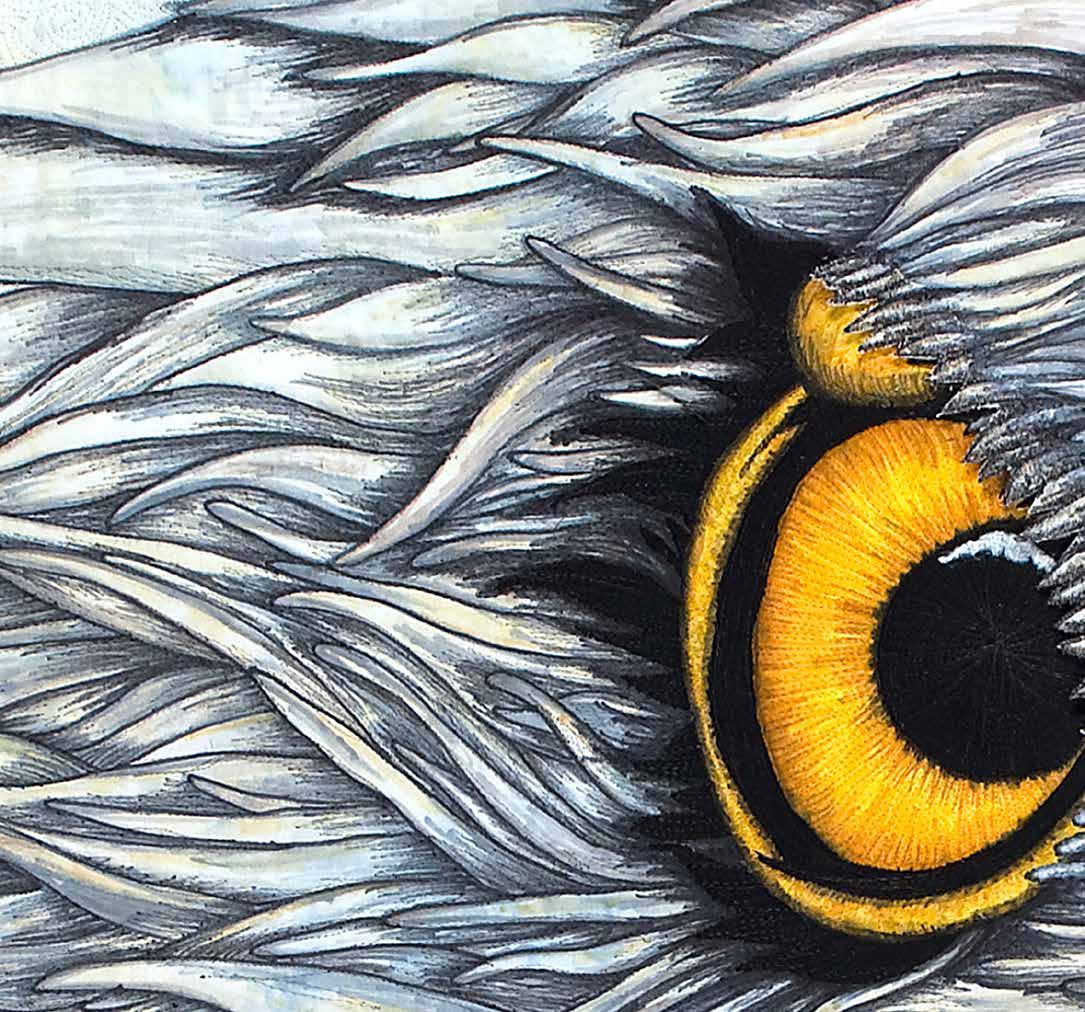
Silk noil, cotton, pigments, wood
Raw-edge appliquéd, mounted, hand-colored with pigment and ink
18

Eagle - The Eyes Have It 30 x 40 inches | 2015
19
Photo by Michael Arterburn
Giny Dixon
Danville, California | USA
A dead whale was found at dawn, wedged under a bridge, in the Oakland Estuary. In a strange way, I saw beauty in the decomposing mass of the marine mammal. I proceeded to replicate a portion of the color and texture of the carcass. It was towed to the Marine Mammal Center, where biologists determined it died from trauma, and it was identified as a juvenile female fin whale. Of the endangered whale species, she is one of more than 80 whales confirmed as being killed each year by ships off the coasts of California, Oregon, and Washington. Collisions with ships are a major cause of mortality for blue whales, humpback whales, and fin whales. With small populations, every death makes a difference.
Cotton, linen, silk, nylon horsehair, upholstery fabric Dyed, cut, machine pieced, machine quilted, hand sewn

20
Coastal Passage: Beautiful Victim
41.5 x 43 inches | 2018

21
Photo by Sibila Savage
Isabelle Dupras
Drummondville, Quebec | Canada
Urubu is based on the dark turkey vulture, which is increasingly present in our northern landscapes. This unloved bird is nevertheless very interesting to observe up close because of its bald, red head. Urubu is part of a series of quilts called Volatile, which is inspired by the plumage of Quebec birds. The Volatile series does not seek to illustrate birds, but rather evoke an impression of color—a bit like looking at the birds through a kaleidoscope. The red leather pieces in the work are from an old-fashioned leather coat and complete the allusion by recalling the bird’s bald head.
Cotton, red leather coat
Improvisationally pieced, assembled, cut, tied
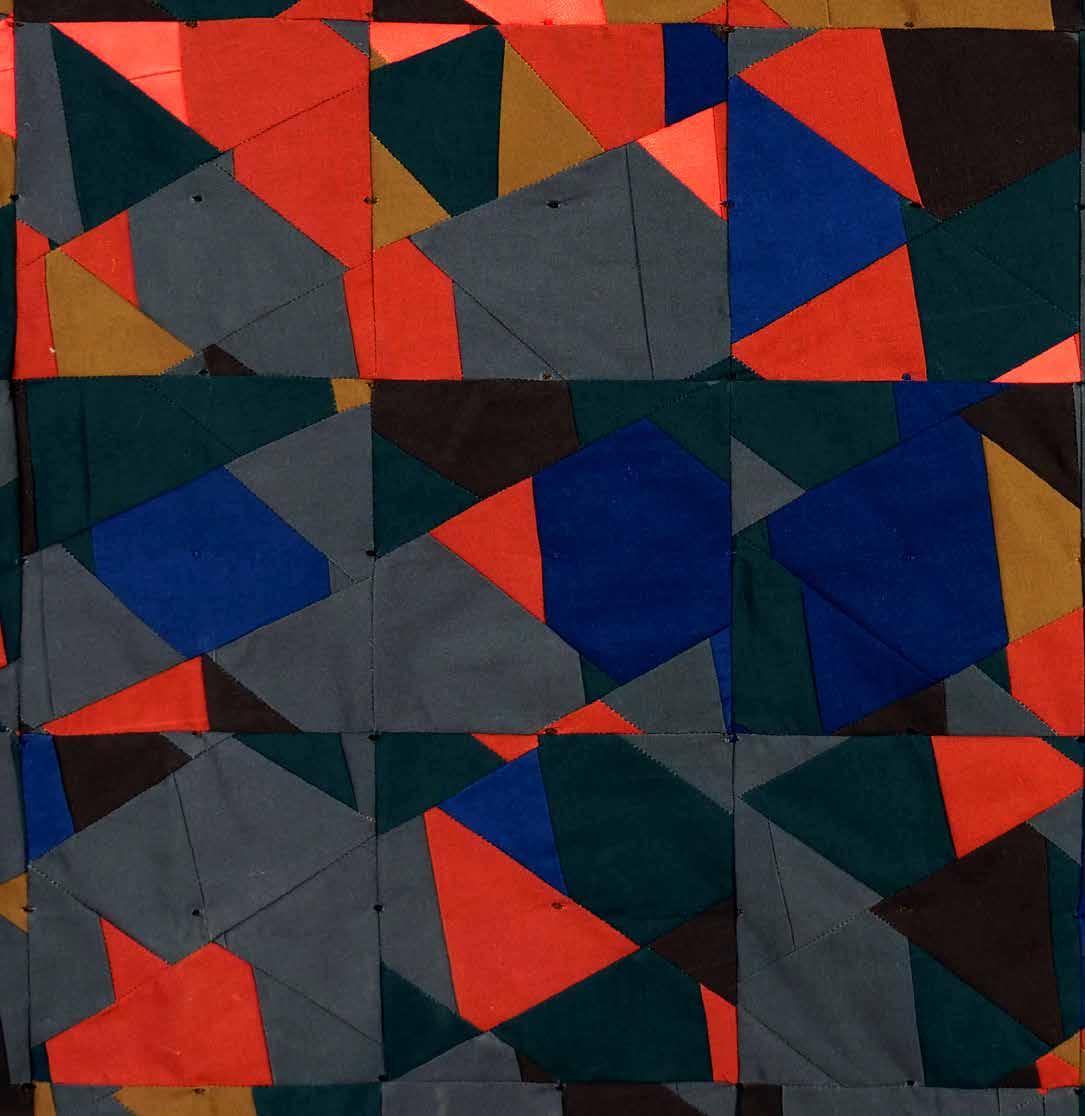
22

Urubu 50 x 80 inches | 2019 23
Caryl Bryer Fallert-Gentry
Port Townsend, Washington | USA
This quilt began with a small sketch I made in 1989, shortly after returning from Australia and the Great Barrier Reef for the first time. I’ve kept the sketch for many years, and almost every time I’ve returned from a snorkeling trip I have made a new interpretation. The shape of the fish bodies and tails are a fantasy amalgam of many different species. The colors and patterns were inspired by parrot fish and other brilliantly colored tropical fish.
 Cotton
Cotton
24
Hand dyed, machine pieced, appliquéd, quilted

Aquarium #2 30 x 30 inches | 2014 25
Joyce King Ferrie
Englewood, Florida | USA
Tarpon, also known as the silver king, is a prehistoric inhabitant of the Gulf of Mexico. These fish travel in large schools creating their own highway. Daisy-chaining is their mating dance where they swim nose to tail. It is a gift to watch an accomplished fly fisherman hunt the silver king. He waits for the disturbance on the water indicating the tarpon’s presence, then beautifully casts his line, presents the fly, and waits for the strike. The tarpon gives a spectacular show as it leaps high out of the water then dives back, creating an explosion on the water’s surface. The silver scales look like diamonds when they catch the sunlight. Another leap and the tarpon begins to tire. Out of respect, the angler bows to the silver king and releases it unharmed back to the water.
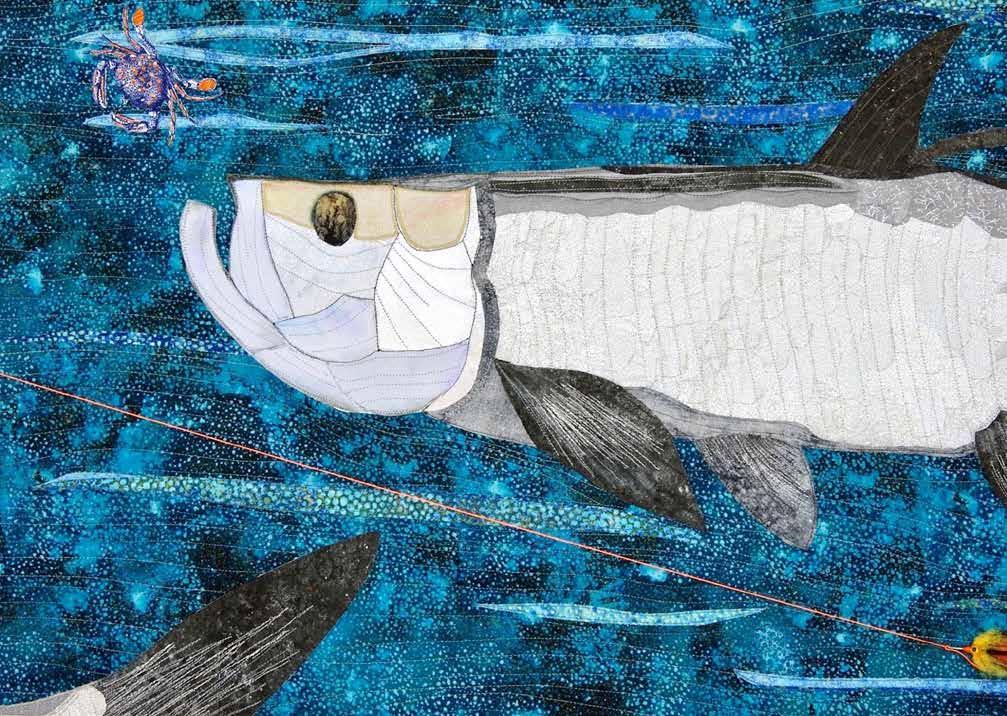
Cotton, fashion fabrics, fly line, fishing fly, ink pencils
Machine quilted, hand embroidered, raw edge appliquéd, thread painted
26

The Silver King Highway 35 x 45.5 inches | 2021 27
Margaret “Peggy” Fetterhoff
Spring, Texas | USA
The seahorse is the only species where the male carries and delivers the babies. If there is reincarnation, I want to come back as a female seahorse.
Cotton, polyester
Machine pieced and quilted, appliquéd, thread painted

28

Daddy Seahorse 55 x 55 inches | 2020 29
Jayne Bentley Gaskins
Reston, Virginia | USA
It’s not hard to find overdressed, self-appointed experts making loud proclamations on any number of subjects. They look good, they’re charismatic, and being eloquent, they sound good too. Their words, however, lack substance and are rarely based on fact. Sadly, other creatures caught up in the pageantry parrot this empty rhetoric without a second thought. Is that where we get the term birdbrain?
Thread painted, appliquéd, trapunto quilted, hand embroidered, machine quilted
 Cloth
Cloth
30
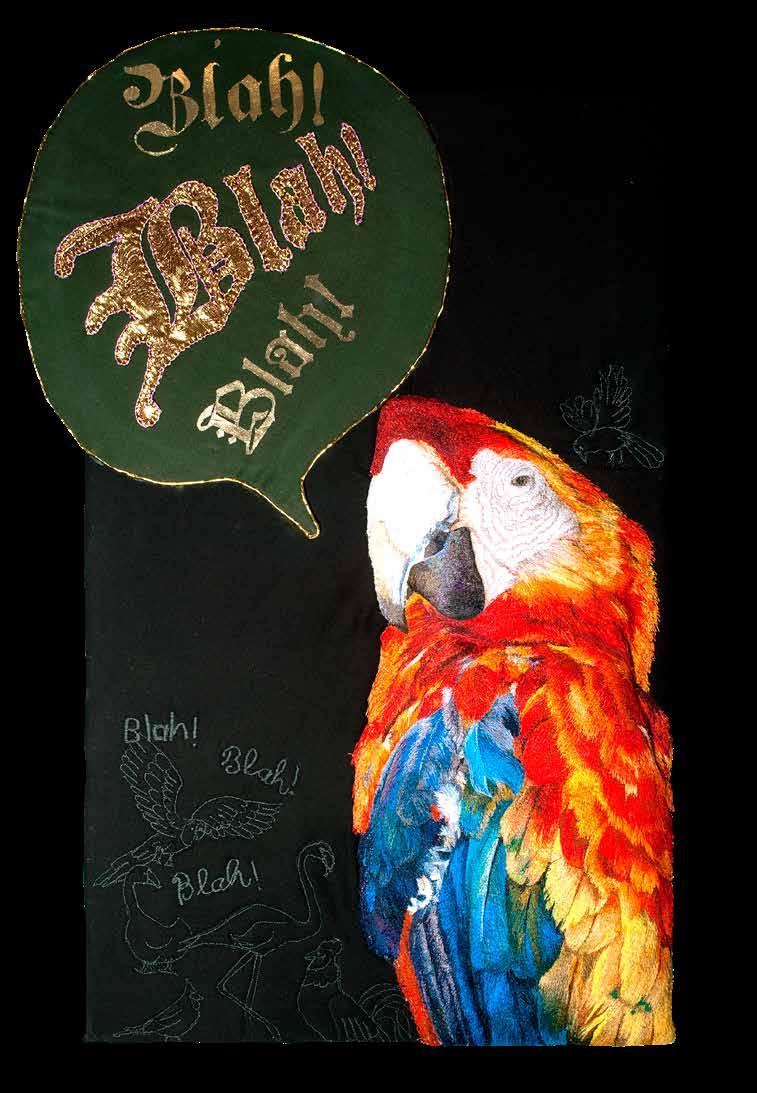
Pointless Parroting 30 x 17 inches | 2019 31
Betty Hahn
Sun City, Arizona | USA
The skin, shape, and color of this lizard were much more interesting to me than the whole lizard. An abstraction was the answer.
Silk charmeuse, wool, acrylic paint, dye Hand painted, quilted

32

Thinking of Getting Another Tattoo 37 x 36 inches | 2020 33
Nari Haig
Whitefish Bay, Wisconsin | USA
My quilts tend to be nature-based. I’ve been exploring the concept of enlarging smaller images, allowing the details to be more pronounced. The tiny, broad-billed hummingbird measures about 4 1/2” in height, so I chose to scale up this bird enough that the viewer can identify it without needing to see the whole bird. Over 800 feather barbules were made in this piece.
 Cotton
Cotton
34
Raw edge appliquéd, free motion quilted
 Broad-billed Hummingbird
49.5 x 40 inches | 2019
Broad-billed Hummingbird
49.5 x 40 inches | 2019
35
Photo by Susan Haig
Irene Anna Koroluk
Taroona, Tasmania | Australia
The cold coastal waters of Tasmania, Australia have an array of fascinating and intriguing sea creatures. In Jellies, Stars and Screws, a jellyfish bloom propels its way through a kelp forest, sea stars scavenge the bottom of the seabed, and screw mollusks hide from the predatory sea stars in the depths of their shells.
Jellyfish are the oldest multicellular animals on the planet and have existed for around 650 million years, whilst brittle stars, sea stars, and mollusks have roamed the sea floors and rock pools for between 400-500 million years. It is truly amazing that jellyfish, brittle stars, and sea stars can clone themselves and regenerate their body parts; brittle and sea stars can amputate one or more of their appendages to escape predators (a process called autotomy), and sea stars can use autotomy for asexual reproduction.
Blue fabric, ink, acrylic marker
Free motion stitched, drawn, painted

36
 Jellies, Stars and Screws
37 x 27.5 inches | 2021
Jellies, Stars and Screws
37 x 27.5 inches | 2021
37
Photo by Bruce Champion
Glenda Mah
Salem, Oregon | USA
Every summer I spend time on the Oregon Coast. One year our house faced the bay, and at low tide the cranes would arrive and stand at attention in the mud.

Cotton, natural indigo
Hand stitched, hand dyed, discharged, raw edge appliquéd, machine quilted
38
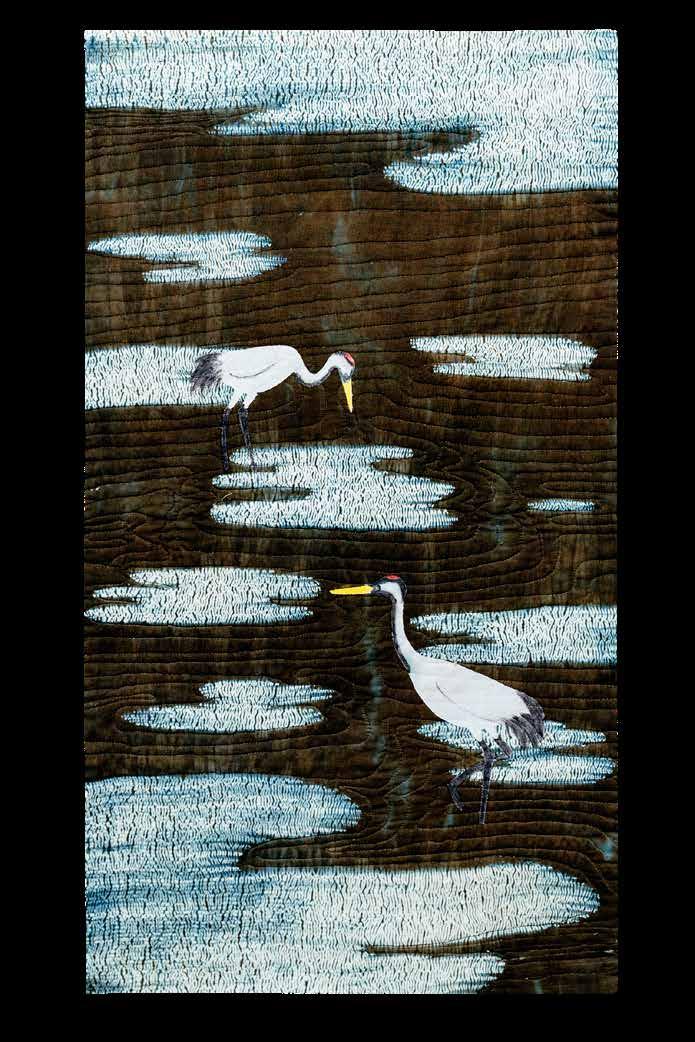
Estuary 35 x 19 inches | 2019
39
Photo by BENMA Photo
Jeanne Marklin
Williamstown, Massachusetts | USA
In Ireland, the magpies look like they have tuxedos on— until they take flight. Then their wings have an iridescent shimmer as the sun catches their feathers. It’s always a surprise to see that glimmer from a common, black-andwhite bird!
 Cotton
Cotton
40
Dyed, Shibori pole wrapped, machine pieced and quilted

Magpie 47 x 37 inches | 2013 41
Salli McQuaid
Walla Walla, Washington | USA
Before people let pet pythons loose in the Florida Everglades, there were many species of animal wildlife. The alligator was the top predator, but now the python is vying to take its place. Pythons can constrict alligators of up to 10 feet—only giant alligators can escape. The cunning python hides so well that it’s nearly impossible to cull their overflowing numbers. When given the opportunity to view these pythons, they are impressive. Their muscular, shiny bodies wind in and out of graceful curves. However impressive, it is sad to realize that the Everglades are now dominated by these dangerous snakes.
Aboriginal batiked fabric, cotton
Designed, pieced, appliquéd, decorator stitched, longarm quilted
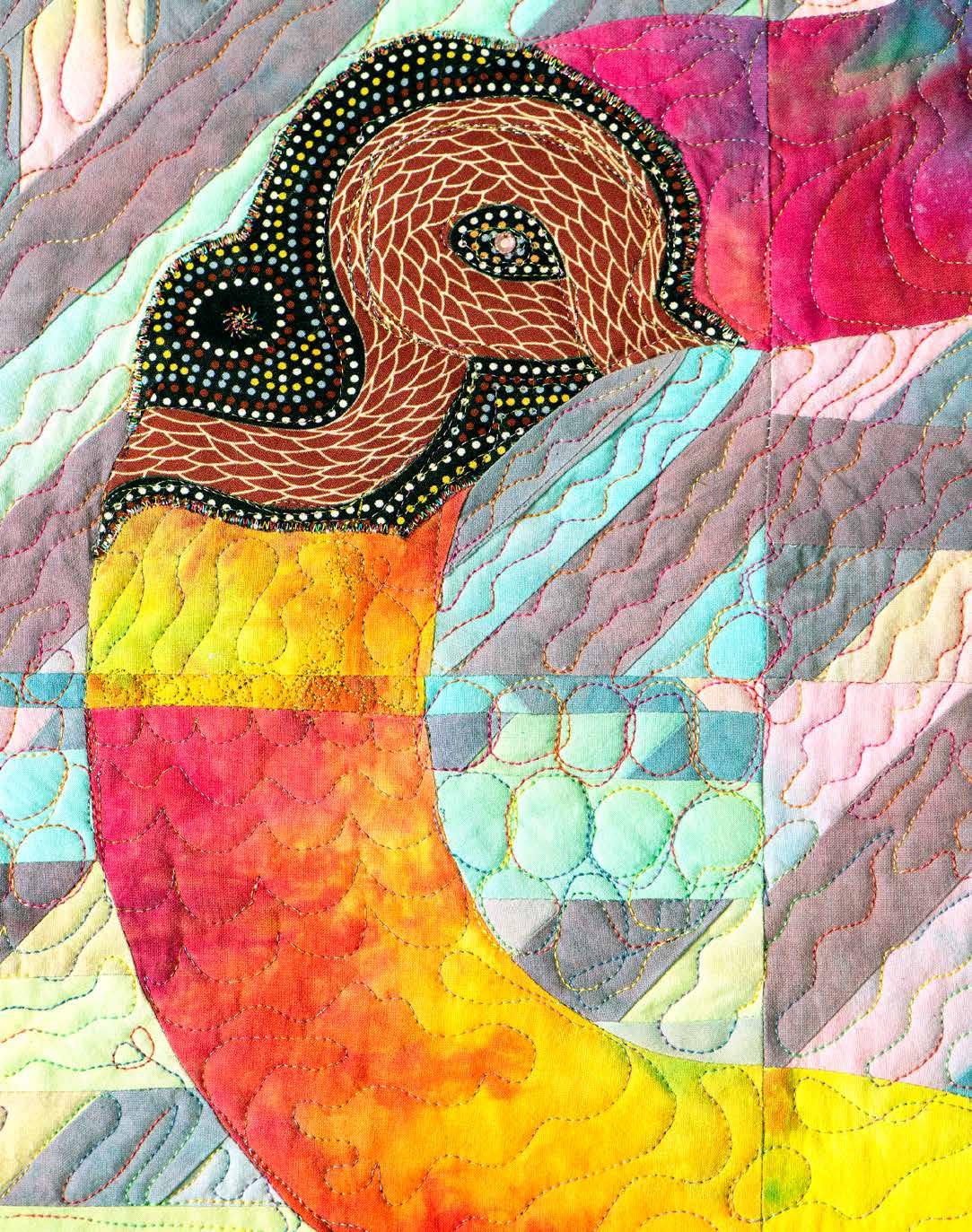
42
 Rainbow Python 39 x 18 inches | 2014
Rainbow Python 39 x 18 inches | 2014
43
Photo by Cleary Creative Photography
Kestrel Michaud
West Melbourne, Florida | USA
Her skin might be leathery, but this lovely lady enjoys soaking up the sunshine. That big, toothy grin says she’s living her best life out in the Floridian swamps. Even apex predators need beauty sleep! The kaleidoscope of Florida-native butterflies is treating this gorgeous gal to her very own “princess” moment. These butterflies are all found in my own backyard and neighborhood. The alligator, fortunately, is not.
Cotton, Mod Podge, fusible interfacing Fused, raw-edge appliquéd

44

36
48
| 2020 45
Beauty Queen
x
inches
Karen I. Miller
Corvallis, Oregon | USA
A lizard’s beaded skin can have wonderful camouflage patterns that are sometimes pretty dramatic. I designed the stencils for this quilt top with a variety of patterns inspired by lizard skin.
Silk broadcloth, soy-based pigment dyes
Katazome stencil dyed, free motion quilted

46
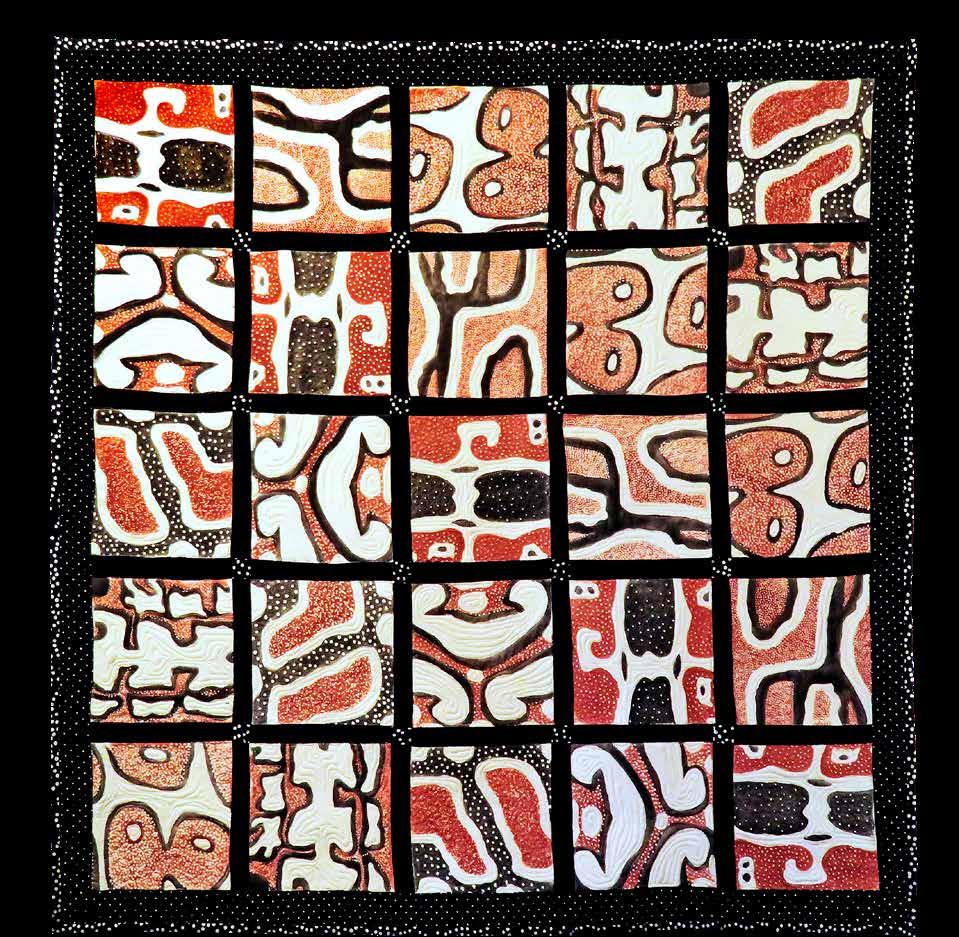
Lost in the land of lizards 40 x 40 inches | 2019
47
Photo by Edward L. Miller
Lulu Moonwood Murakami
Milwaukie, Oregon | USA
Every morning begins with a walk in the woods or along the riverbank, where I closely observe the color and shape of leaves, or the yearning branches absent of leaves. Each season has surprising delights. This spring it has been rabbits—more than I’ve ever seen before. They have become a symbol of renewal for me, a symbol of hope.
Cotton
Appliquéd, reverse appliquéd, hand stitched, embroidered, quilted

48

Renewal 52 x 41.5 inches | 2021 49
Jeannie Palmer Moore
Kerrville, Texas | USA
Buck is a wild blackbuck antelope who resides in the Texas Hill Country. He has very distinct facial markings and spiral black horns. Blackbuck antelope were first introduced to Texas in the early 1900s from India.
Cotton, newspaper, fusible web, ink
Newspaper transferred, painted, thread painted, quilted
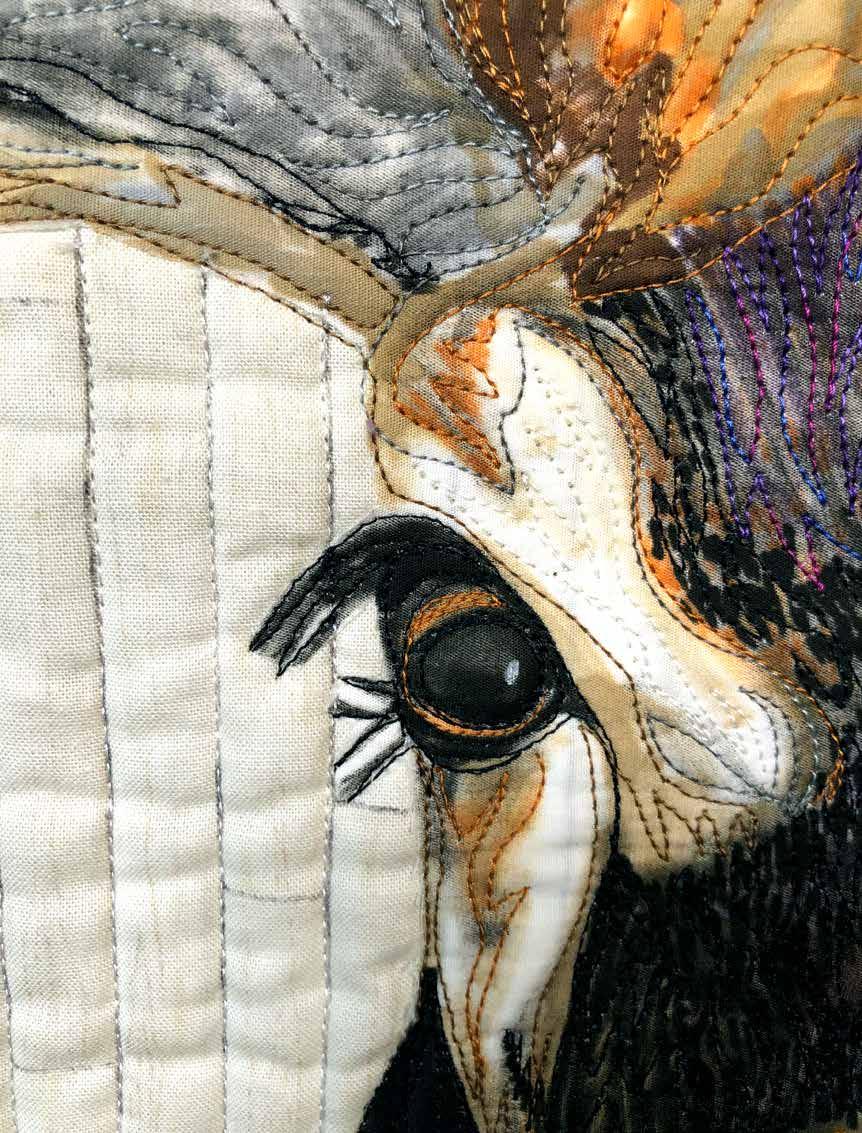
50

51
Buck 39 x 25 inches | 2020
Claire Passmore
Chipping Norton, Oxfordshire | United Kingdom
The spectacular moment when a whale’s enormous fluke breaks the surface is a truly awesome sight and a reward to those who are patient. The first time I saw this wonder was in 2006 in the town of Hermanus, South Africa, where around 100 southern right whales go to calve each winter. I remember the swirling ocean gradually erupting, and in remarkable slow motion, a huge tail breaking through the surface just before a whale prepared for a deep dive in search of food. In this piece, I have re-imagined that moment, with an ocean of gently folded curves, broken only by an enormous single tail.
Cotton organdy, glass organza, non-woven wood pulp/polyester fabric, recycled book pages, acrylic medium, lace, cord, fiber reactive dye, wire, folding acrylic support
Hand dyed, paper laminated, sculpted, embroidered, hand knotted

52
 Southern Right Whale: Deep Dive
Southern Right Whale: Deep Dive
53
32 x 20 x 17 inches | 2021
Maureen Phillips
Cary, North Carolina | USA
After protecting a nest from predators, it is a thrilling moment for conservancy volunteers to watch endangered baby sea turtles hatch and rush toward the ocean under the moonlight.

Cotton, fusible web
Hand appliquéd, hand embroidered, hand quilted
54

It’s time! 33.5 x 56 inches | 2021 55
Ruth Powers
Carbondale, Kansas | USA
The northern harrier is a ground-nesting, low-flying hawk with a distinctive owl-like face. As they are permanent residents here in Kansas, I see them often. The males are snowy white underneath with inky black wingtips. This scene is very like one I saw last spring near where I live, but I have only memories—no pictures. Bird photographer Ashok Khosia graciously gave me permission to use one of his photos as a reference.
Commercially printed and hand-dyed cotton Machine pieced, free motion quilted

56

Harrier Hunting 42 x 51 inches | 2012 57
Sue Reno
Bethel Park, Pennsylvania | USA
The small mammals that make their homes in my suburban habitat interest me, and I enjoy observing them as they go about their daily routines. Their eventual demise and skeletal remains sadden but also intrigue me. For years I’ve worked on an ongoing series of quilts made with imagery from the skeletons.

For Mole and Fern, I took macro photographs of an eastern mole skull (Scalopus aquaticus), which I used to make prints. I also made prints of the ferns that grow in the area where I observed mole activity. Hand-stitched hexagon panels loosely represent their underground tunneling activity.
Photographic images, cyanotype panels, heliographic print panel, hand-painted and commercial cotton, silk, linen, wool
Photographed, monoprinted, hand stitched
58
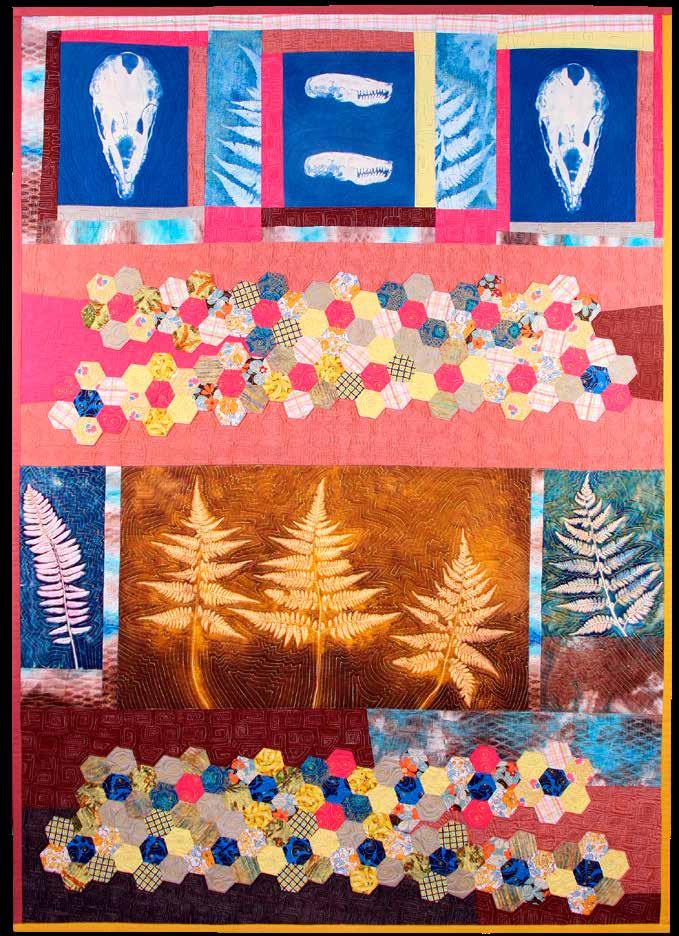
2021 59
Mole and Fern 57 x 40 inches |
Cindy Richard Beit Shemesh | Israel
This monkey lives in the safari in Tel Aviv, Israel where he can roam freely. He was very playful, and I caught him hanging out in the trees with his friends. He has a bit of an exasperated expression, though. Maybe his kids were driving him mad, or maybe a visitor to the safari upset him. He was probably ready for a nap but was disturbed by some noise. In any event, he came by to see what was going on outside his habitat. He sat down beside this tree and just stared back at us.

Cotton, wool
Fused, collage appliquéd, free motion quilted
60

Monkey Business 31 x 19.5 inches | 2021 61
Nancy Ryan
Gardnerville, Nevada | USA
Walking along the Carson River in northern Nevada with my camera, I happened to come across these two amazing, beautiful birds who were doing their mating dance. The way they moved with grace and precision is what captivated me to take their picture and create this piece.
Cotton, satin
Painted, fused, machine stitched
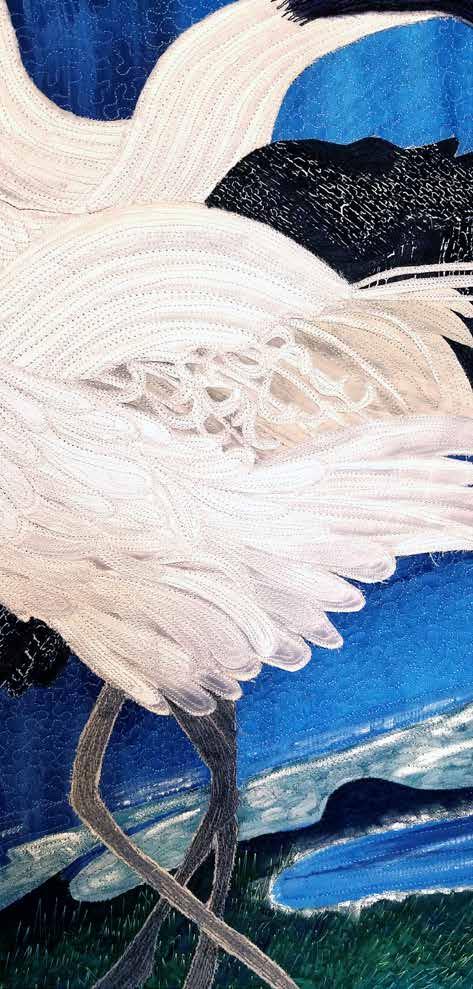
62

to Tango
x 34 inches | 2020 63
Two
37.5
Sara Sharp
Austin, Texas | USA
Coastal Cousins is based on my photograph of a brown and a white pelican which I spotted on a trip to the Texas Gulf Coast. White pelicans are found throughout North America’s inland and coastal waters, while brown pelicans are confined to its warmer southern coasts. Their large flocks fly in formation before settling in noisy groups on the water. Pelicans’ distinctive bills are not used to store food, but to scoop up and strain out the small fish they eat. It is amazing to watch brown pelicans plunge from on high to catch prey, or glide slowly just above the water. White pelicans tend to float on the surface while searching for their favorite fish. Brown pelicans became endangered in the 1970s due to pesticide runoff, but through conservation efforts their numbers have increased.

Commercial and hand-dyed cotton, monofilament, fusible interfacing, fusible web, colored pencils
Raw edge appliquéd, free motion quilted, thread painted
64

Coastal Cousins 38 x 28 inches | 2021 65
Sue Sherman
Newmarket, Ontario | Canada
The Galápagos marine iguana has evolved the unique ability to eat algae from the ocean in an area where food is scarce on land. They are classed as vulnerable due to their extremely limited range, and they are especially impacted by El Niño climate patterns. I find their spiky faces fascinating and really enjoyed individually painting and quilting each scale and point.

Cotton lawn fabric, dye
Dye painted, machine quilted
66
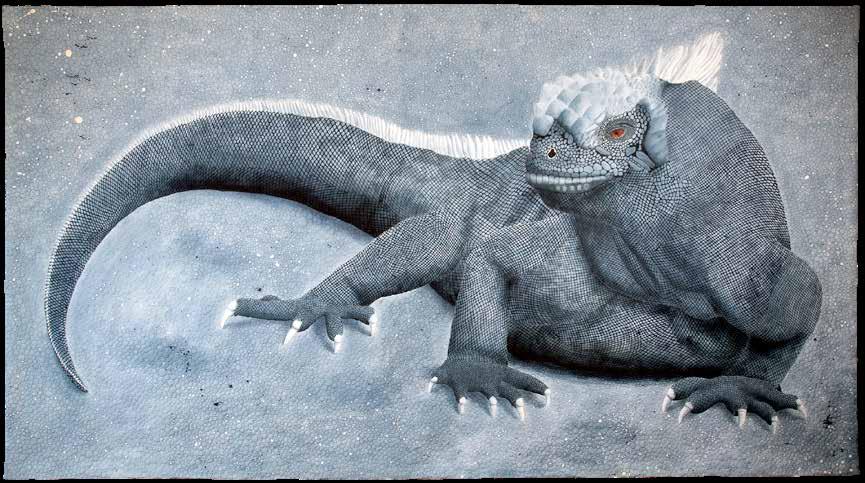
Galápagos Marine Iguana 48 x 88 inches | 2020 67
Carolyn Skei
McKinney, Texas | USA
On an excursion to a village cathedral several summers ago, I captured a photograph of a plainly dressed man feeding birds in the church courtyard. In the busy midst of buses, shoppers, and tourists, the birds and the man shared a simple and probably frequent communion. The scene reminds me of stories of Saint Francis of Assisi— known to townsfolk as Poverello, “the poor one”—so I named the quilt Poverello and the Birds.
Commercial and hand-dyed cotton, fusible web, photograph
Digitally designed and manipulated, hand cut, fused, stitched

68

30 x 40 inches | 2021 69
Poverello and the Birds
Brenda Gael Smith
Copacabana, New South Wales | Australia
Galahs are a gaudy mob and gather in a swooping haze of grays and pinks.
Cotton
Hand dyed, pieced, machine quilted
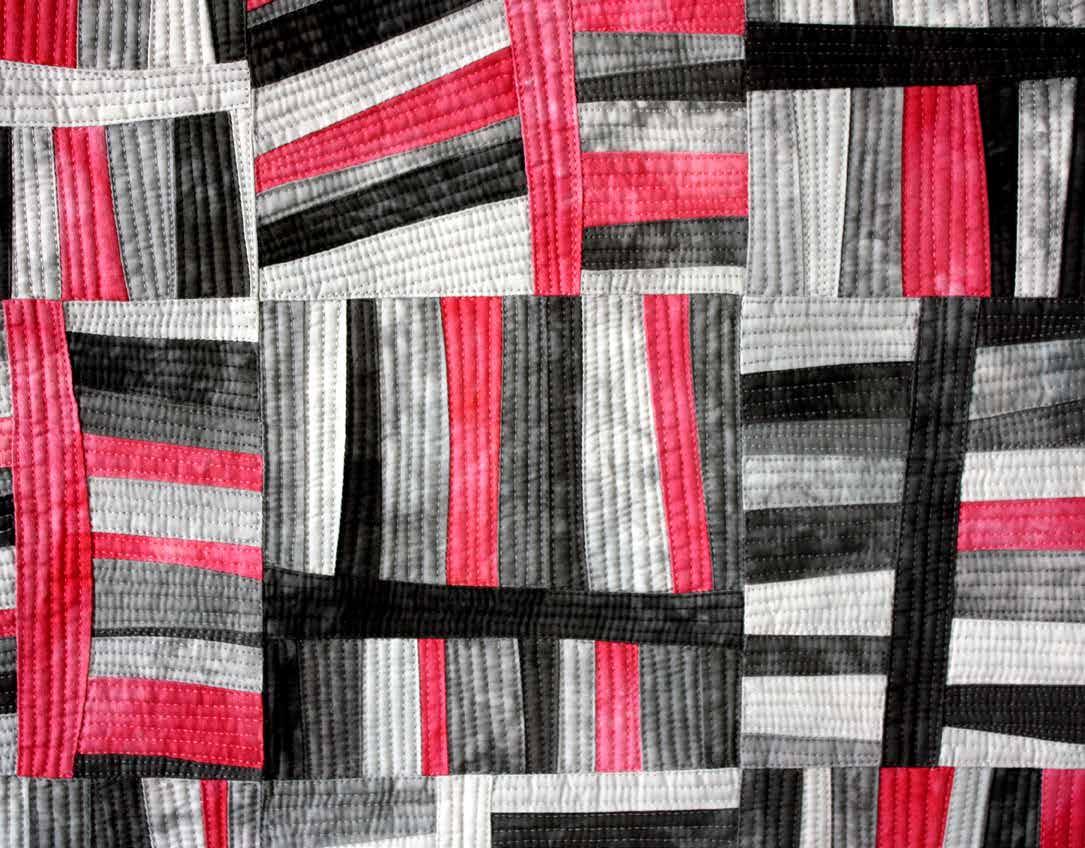
70
Flying Colours: Galah Gala
30 x 30 inches | 2015

71
Marinda Stewart Round Rock, Texas | USA
The extraordinary leafy sea dragon, a relative of the sea horse, is found only along the southern Australian coast. They have no natural enemies, primarily because of their camouflage. They are beautiful and benign. Their numbers are diminishing as mankind threatens our oceans throughout the world.

72
Cotton, silk ribbon, beads, acrylic paint Machine quilted, appliquéd, hand embroidered, beaded, painted

Leafy Sea Dragon 32 x 21 inches | 2021
73
Photo by Amy C. Nelson
Karin Tauber
Blacksburg, Virginia | USA
The tiny Monteverde golden toad is famous worldwide for its rarity and beauty. Its glamor was nature-made, but its mysterious decline was due to humans. Golden toads, also known as “little jewels of the forest floor,” were never widespread, but they were once abundant in the highly elevated tropical cloud forest area above the Costa Rica town of Monteverde. No one has seen a golden toad since 1989. Scientists believe that rising temperatures may have driven this species to extinction.
Cotton, fusible web
Discharged, stamped, screen-printed, hand dyed, pieced, machine quilted

74

Golden Frogs of Monteverde 55 x 39.5 inches | 2015 75
Sherry Turpenoff
Glen Carbon, Illinois | USA
Diversity is a core element of America’s openness, freedom, and creativity. This quilt builds a beautiful fabric by juxtaposing opposites and a rainbow of colors. Yet, as in chaos theory, a subtle but important change occurs at the edges of the figures. Colors begin to merge just as cultures, races, and ethnicities slowly merge, reminding us of the rich, exciting country diversity has created. I hope for a return to an appreciation of the incredible ideas with which we are blessed. When we listen to and care about each other, we can build a society better for all.

Cotton
Applipieced, fused appliqué, machine appliquéd, free motion quilted
76

Celebrate The Beauty Of Diversity 30 x 37 inches | 2018 77
Sandra Wagner
Pine Grove, California | USA
Life in the Cold was inspired by a trip to the Polar Bear Research Center in Churchill, Manitoba, Canada. I enlarged images of the bears and the helicopter, then printed them onto fabric. When polar bears get into trouble, they are taken by helicopter and relocated. With the warming of our earth’s climates, their area for survival is shrinking.

Cotton, poplin
Digitally enlarged, printed, hand dyed, pieced, machine quilted
78
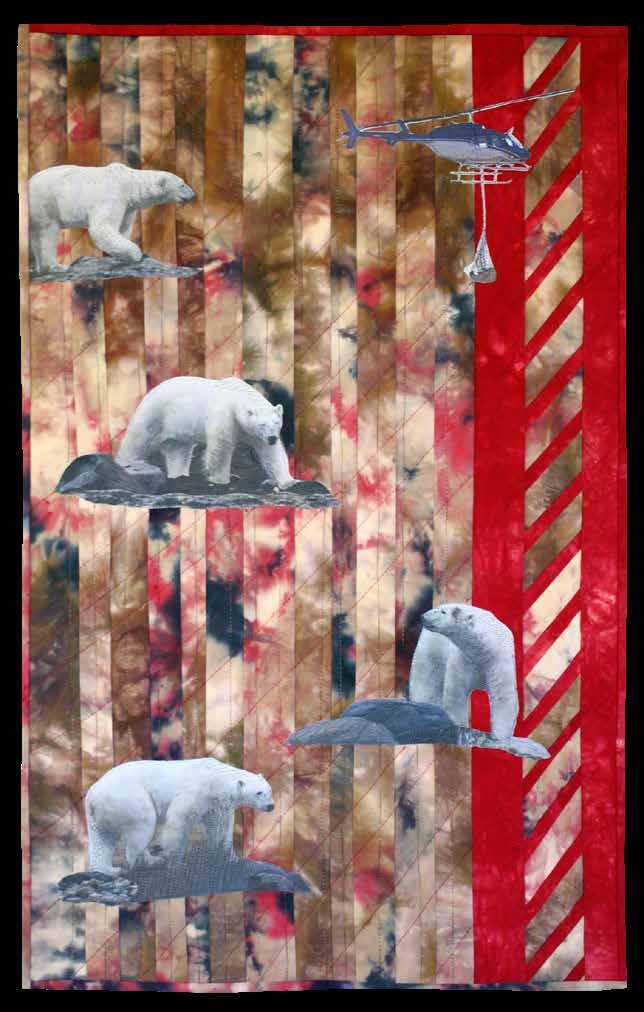
Life in the Cold 35.5 x 22 inches | 2021 79
Katie Walwyn
Vancouver, Washington | USA
These two creatures actually appeared in the same field of view in the Galapagos Islands, begging to be captured in fabric. The dichotomy of seeing Antarctica and the equator meld was magnificent to experience. Both are so clumsy and awkward on land, yet graceful and elegant in the water. Their existence is loved, admired, and worthy of celebration.

Hand-dyed cotton and wool, commercial cotton, crystal beads
Raw edge appliquéd, trapunto quilted, hand embroidered, hand beaded, machine quilted
80

Flippers
Fabulous
50 x 46 inches | 2019
81
Photo by Angelia Peterson
Rosanna Lynne Welter
West Valley City, Utah | USA
On the vast plains of the United States, wild horses have roamed free for hundreds of years. These majestic animals graze in herds that include roans, bays, blacks, sorrels, buckskins, grays, palominos, and black and whites. Roans are horses with hair of many interspersed colors. It is estimated there are around 500,000 wild horses left in the world today. Limiting herd size while maintaining genetic viability, and managing resources such as water, are controversial issues. Sparse spring rains bring rapid growth for desert vegetation. With the worst drought season ever looming in the western United States, the green plants will soon turn brown, watering holes will dry up, and an extreme fire season awaits. Onaqui Roan is based on photos by local wild horse photographer Kent Keller.
(Photos used with permission)
Satin, cotton, dye, ink
Dye painted, torn, heat transferred, ink stamped, drawn, raw edge appliquéd, machine quilted

82

Onaqui Roan—On The Run 35 x 30 inches | 2021 83
Libby Williamson
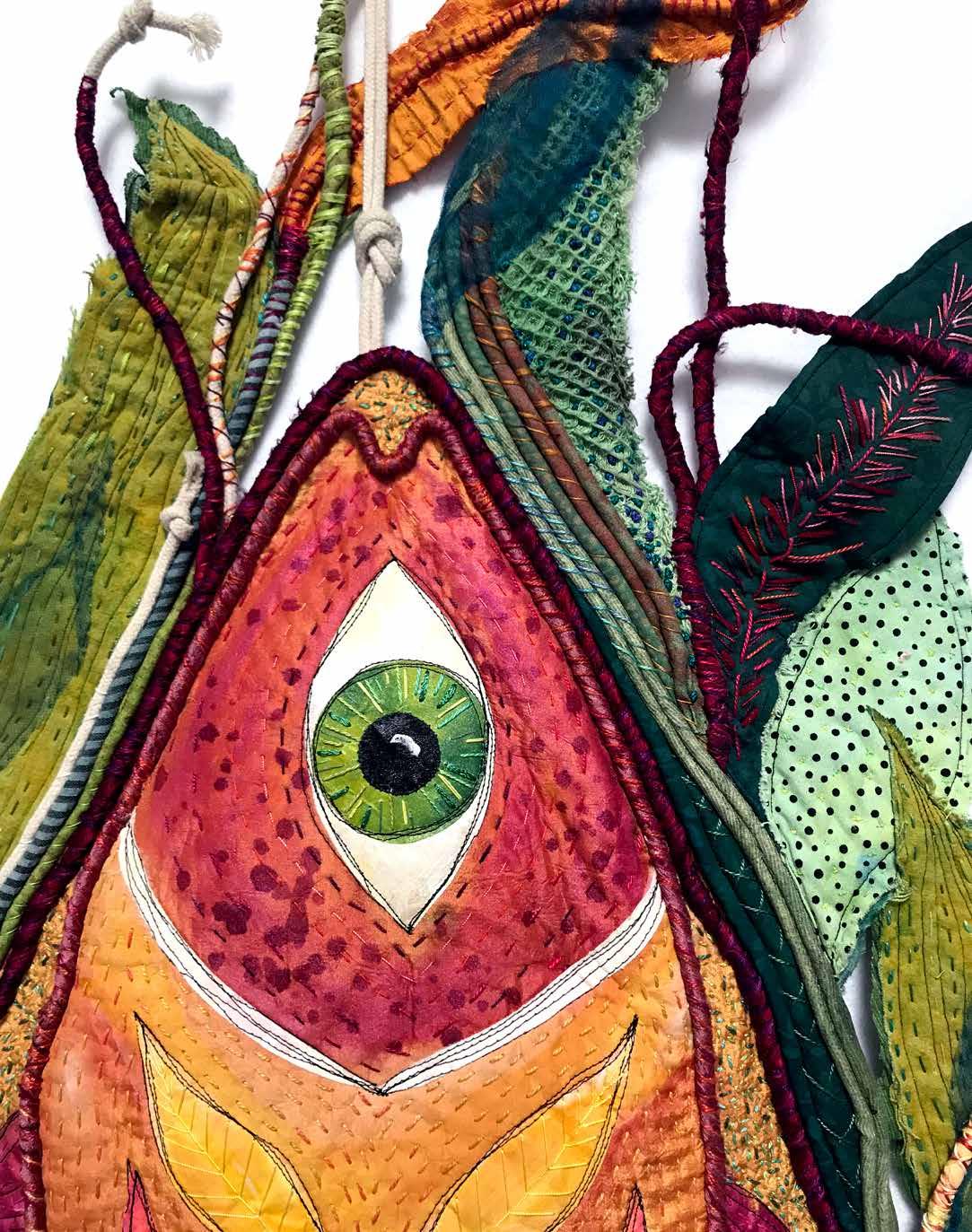
Villa Park, California | USA
Mini marshmallows, orange cheese, or pre-chewed Chiclets, stabbed through a securely closed safety-pin and dangled from some old string—this was fishing back in the summer of 4th grade. The end goal was to never, ever touch a slimy fish, much less eat one. Instead, Laura and I were content to sit on the toasty-warm stone bridge above Mill River and feed the fish below. With a tug on the line, they would nibble the bait, spit it out, and escape unharmed. Time slipped by, and we became bait for mosquitos. With sunburns and scraped knees, we’d skip home with stories of the ones that got away.
Cotton, polyester, flannel, utility cloth, felt, recycled sari silk ribbon, clothesline rope, metal washers, cheesecloth, tulle, wire, safety pin, acrylic paint
Free motion quilted, hand embroidered, fabric painted, couched
84
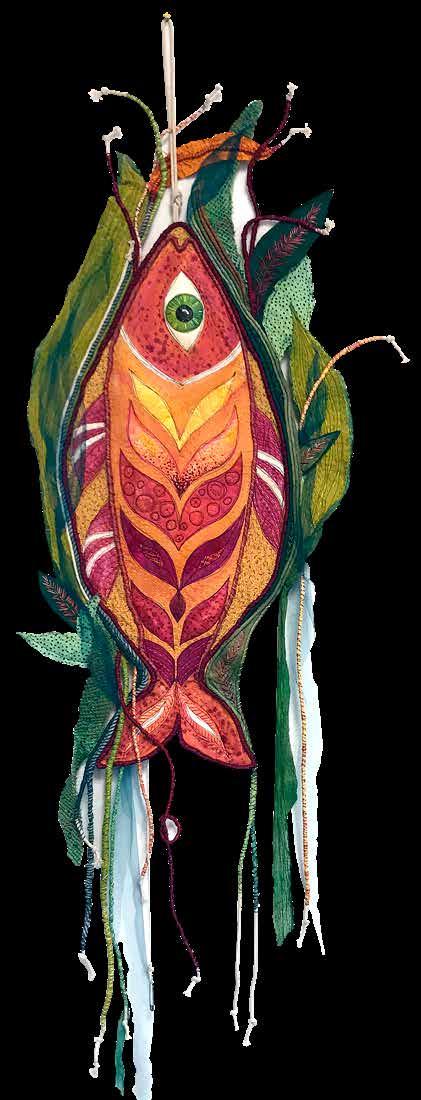
Disentangled 72 x 24 inches | 2021 85
Krista Zeghers & Coreen Zerr
Treherne, Manitoba | Canada
Photographs from a safari trip in the Serengeti were the inspiration for this work. The male lion was peeking out from behind an acacia tree—both popular symbols of Africa. Ghost images of African animals are embedded in the quilting to extend the moment. African rooibos tea was used to dye some of the fabric in the strip-pieced landscape, and hand-dyed wool from sheep shearing was used for the lion’s mane and foreground grasses.
Raw sheep fleece fibers, dye, commercial fabric, tulle Thread painted, felted, machine quilted, dyed

86

Serengeti Moment 30 x 70 inches | 2014
87
Photo by Don Zeghers
9 781734 903362
2 0 0 0 >
5
ISBN 978-1-7349033-6-2 $20.00













 The Armadillo and the Cow
35 x 49 x 4 inches | 2021
The Armadillo and the Cow
35 x 49 x 4 inches | 2021








 Cotton
Cotton





 Cloth
Cloth



 Cotton
Cotton
 Broad-billed Hummingbird
49.5 x 40 inches | 2019
Broad-billed Hummingbird
49.5 x 40 inches | 2019

 Jellies, Stars and Screws
37 x 27.5 inches | 2021
Jellies, Stars and Screws
37 x 27.5 inches | 2021


 Cotton
Cotton


 Rainbow Python 39 x 18 inches | 2014
Rainbow Python 39 x 18 inches | 2014









 Southern Right Whale: Deep Dive
Southern Right Whale: Deep Dive

































